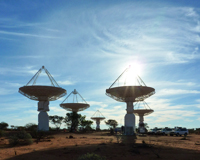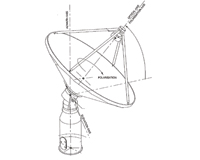New memo points to value of ASKAP's third axis
27 November 2015
Over the last year, the ASKAP Commissioning and Early Science (ACES) team has produced many images of the radio sky during commissioning activities with the Mk I phased array feed receiver systems.
To this end, the Boolardy Engineering Test Array (BETA) has been an invaluable test platform providing insights into the intricate workings of the new telescope and using the new receiver technology for radio astronomy.
The advantage offered by the ASKAP phased array feed receivers is the ability to form many synthetic beams and control the beam shape and direction through a chosen set of parameters. However, these unique features also introduce a new challenge for pointing calibration.
For the team, understanding ‘pointing’ with BETA (and ASKAP) is much more complicated than for other conventional radio telescopes.In telescopes with a feed horn – such as the Parkes or ATCA telescopes – the radio beam direction is fixed relative to the telescope’s structure and defines its pointing direction. Imperfections related to mechanical pointing errors can be determined by measurements of the beam position on the sky and any misalignment can be absorbed in the pointing model.
Additionally, ASKAP’s third axis of rotation – the ‘roll’ axis – may also introduce mechanical pointing challenges that require additional calibration. To combat this, the team has been working on beam measurement and calibration techniques to ensure that the antenna points accurately at the requested position on the sky.
A new technical memo has been published, which details a number of methods used with BETA to refine the pointing corrections used to ensure accurate tracking of sources.
According to Dave McConnell, ACES team leader, two of these methods relate to watching the sun move across the PAF and are used in the first stage, generally with one antenna, to get an approximate pointing. The third method involves using the roll axis to get a more precise measurement, and it is this third technique that will be used repeatedly to achieve more fine adjustments to the pointing.
“This memo explores several methods of determining the relationship between the mechanical drive system and the optical pointing direction of the ASKAP antennas,” says Dave, “While initially it seems that the third axis presents us a challenge, in the end it actually provides the solution. Further work is needed in order to develop this method into something that can be used routinely.”
The ACES team publishes Technical Memoranda which present material arising from ASKAP Commissioning and Early Science activities with BETA. These memos may be read online, and the first eight are also summarised in the latest edition of the ASKAP Commissioning Update.
Back to Latest ASKAP News page.


